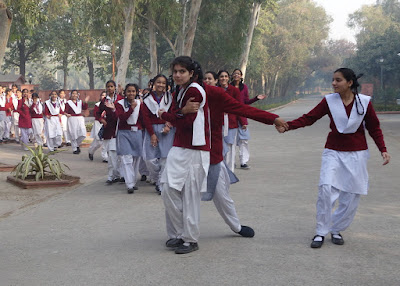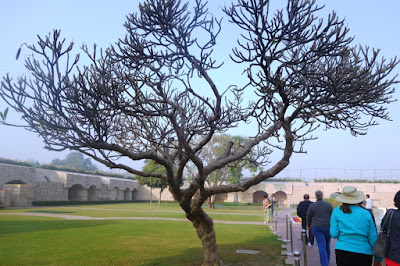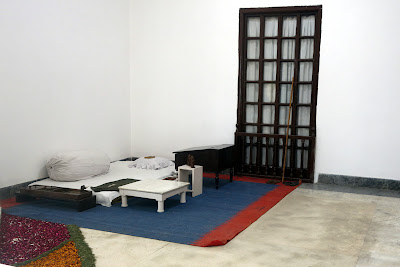Gandhi is one of the most revered people in modern history in India. All of the Indian rupee notes have his picture on them. (Click on the blue underlined words for more information on each topic.)
 |
| A 500 rupee note, worth about US$8 |
We visited the cremation site for Gandhi in Delhi, then the site where he lived in Delhi and was killed, and finally the National Gandhi Museum in Mumbai/Bombay.
Gandhi was born in India in 1869 to a poor family, a time when the British had taken firm control of India. The British had originally come to India to trade and rule in the mid 1700s after the fall of the Mughal (Mongol) Empire. The Mughals had come from the north, married into royal families in India, and established a flourishing culture and economy. Their fall left a vacuum and starting with the British East India company, the British eventually took over rule, but did not integrate in the society, the result of which had a profound negative impact on the socio-economic development of the country.
Twelve years before his birth was the first Indian revolt against the British. Indians are usually a docile, calm people so they needed to be pushed greatly to revolt. Heavy taxation and treatment were among the myriad of causes that led to this revolt, and a rumor soldiers (both Muslim and Hindi) were given cartridges wrapped in paper greased by beef or pork fat which had to be unwrapped by mouth brought the rebellion to a head. Gandhi grew up in this era of discontent.
At 13 he entered an arranged marriage with 14-year-old Kasturba which was to last for 62 years.
 He graduated from high school, and at age 19 went to London to study law, promising his very religious mother that he would abstain from beef, alcohol and women. He got his law degree at 22 and return to India, but was unsuccessful as a barrister. A distant cousin offered Gandhi a job as a lawyer in South Africa, and he ended up staying there from 1893 to 1914, developing his political views and ethical values.
He graduated from high school, and at age 19 went to London to study law, promising his very religious mother that he would abstain from beef, alcohol and women. He got his law degree at 22 and return to India, but was unsuccessful as a barrister. A distant cousin offered Gandhi a job as a lawyer in South Africa, and he ended up staying there from 1893 to 1914, developing his political views and ethical values.
Our first stop was to Gandhi's cremation site called Raj Ghat, on the banks of the Yamuna River. This site was originally the cremation site of (non-Muslim) kings. Stones with quotes of Gandhi adorned the path leading in and helped set the mood for this emotional site. It set the mood for our next stop later in the day, where Gandhi was assassinated on January 30, 1948 by a Hindu extremist. Our guide said that the motives were actually a misunderstanding.
In order to get close to the site, we had to remove our shoes. We had not learned yet to bring along socks to wear so as not to be totally barefoot.
 |
| A quote by Gandhi next to the shoe storage area |
Nava chose to keep her shoes on and walled along the walls and read more quotes of Gandhi and could inhale the air of this peaceful area.
An eternal light burns at one side of the memorial
Over 86% of non-Muslim Indians are cremated in India, often in public cremation ceremonies. We learned that children under seven are not cremated but buried as they are innocent and their original body cells have not been totally replaced. Also pregnant women are buried. The final group of people buried are holy men (and women?).
I had thought that Gandhi was considered a holy man but was told by our guide that he was a very important political man, and so he was cremated like the vast majority of the people in India.
Our second stop was to Gandhi Smiriti or Birla House after the former owners. Gandhi was a frequent visitor to Birla house when he was in Delhi. His last visit there was from Sept 9, 1947 to Jan. 30, 1948 when he was assassinated there. People often asked why he stayed in such a luxurious home and he replied that he wanted Muslims too to be comfortable visiting him there and not in a poorer Hindu district of the city. He was wanted politicians to be comfortable to visit him. He stayed in a rather simple set of rooms where he slept and worked.
 |
| School children also heading to the site |
 |
| Entry to area Gandhi lived |
 |
| Gandhi's worldly remains/possessions at death |
 |
| Of Buddhist origin and in this memorial room |
 |
| World Peace Gong |
 |
| School Children near the site |
Our final stop at a Gandhi memorial was in Bombay/Mumbai, it was in the middle of the bustling city--a very different atmosphere than the first two sites, and in a way too much to absorb as the information was compact and it was a crowded noisy area.. We visited it on our last day in India before flying to Nepal.
The Mani Bhavan, or the National Gandhi Museum, is a modest two-story building that served at Gandhi's Bombay headquarters from 1917 to 1934. In 1955 it was dedicated as a memorial to Gandhi, his life and his activities.
There were a number of pictures of young Gandhi that caught my attention:
 |
| Age 7 |
 |
| At age 14 |
 |
| With his brother Lasmidas in 1886 |
 |
| As a law student in London (between age 19 and 22) |
 |
| As a soldier in South Africa in the Indian corps, 1906 |
 |
| a sculpture of Gandhi near the entrance where a few books are also sold |
One of the main displays was a set of dioramas depicting important stages of his life.
 |
| House in which he was born in 1869 |
 |
| He helps nurse his father during a 5-year illness. Gandhi is 16 when his father dies. |
 |
| When his oldest brother decided to send him to London to become a barrister, he made promises to his mother to not touch wine, women, or meat |
 |
| In 1893 when thrown off a first class train compartment, the incident changed his life |
 |
| Tax march protest in 1913 |
 |
| Return to India in 1915--gaining the title Mahatma ("great soul") |
 |
| Launching of first civil disobedience movement in India |
 |
| 1919 massacre of unarmed people at a peaceful gathering |
 |
| Death of Lokmanya Tilak, 1920, first leader of the Indian independence movement |
 |
| Boycott of foreign cloth--bonfire, 1921 |
 |
| Trial for sedition in 1922 |
 |
| Destruction of village industries, 1925 |
 |
| The Dandi or Salt march, March, 1930, Civil Disobedience protesting the tax British put on local production on salt |
 |
| While serving a 6 year sentence for sedition, in 1927 he had an emergency appendectomy. This is a copy of a rare painting. |
 |
| Meeting with the British King in 1931 |
 |
| Met with Romain Rolland, 1931, French writer who won the Nobel Prize for Literature |
 |
| Fast for the end of Untouchability, 1932 |
 |
| Death of Gandhi's wife, Kasturba, 1944, after 62 years of marriage |
 |
| Pilgrimage of Peace in Bengal, 1946-7 |
 |
| Ghandi to Riot-wrecked Bihar, 1947 |
 |
| Gandhi and Khan bemoaning the division of the country |
 |
| Fast for communal harmony, Sept 1947 |
 |
| Assassination and then cremation of Gandhi, Jan. 31, 1948 |
Two letters from Gandhi to world leaders were also on display, the first to FDR, the President of the US, in 1942,
and most surprisingly was Gandhi's letter to Hitler in 1929.



































































No comments:
Post a Comment